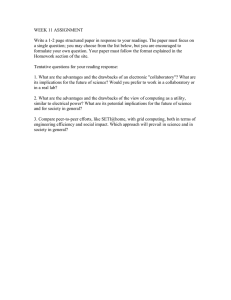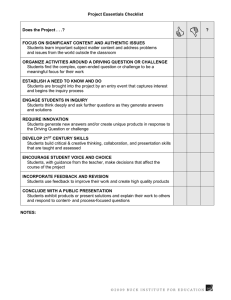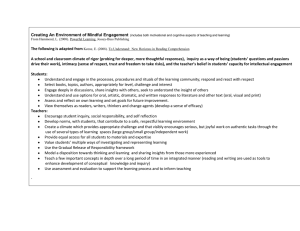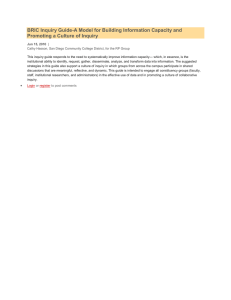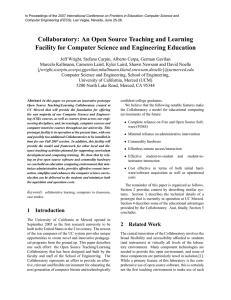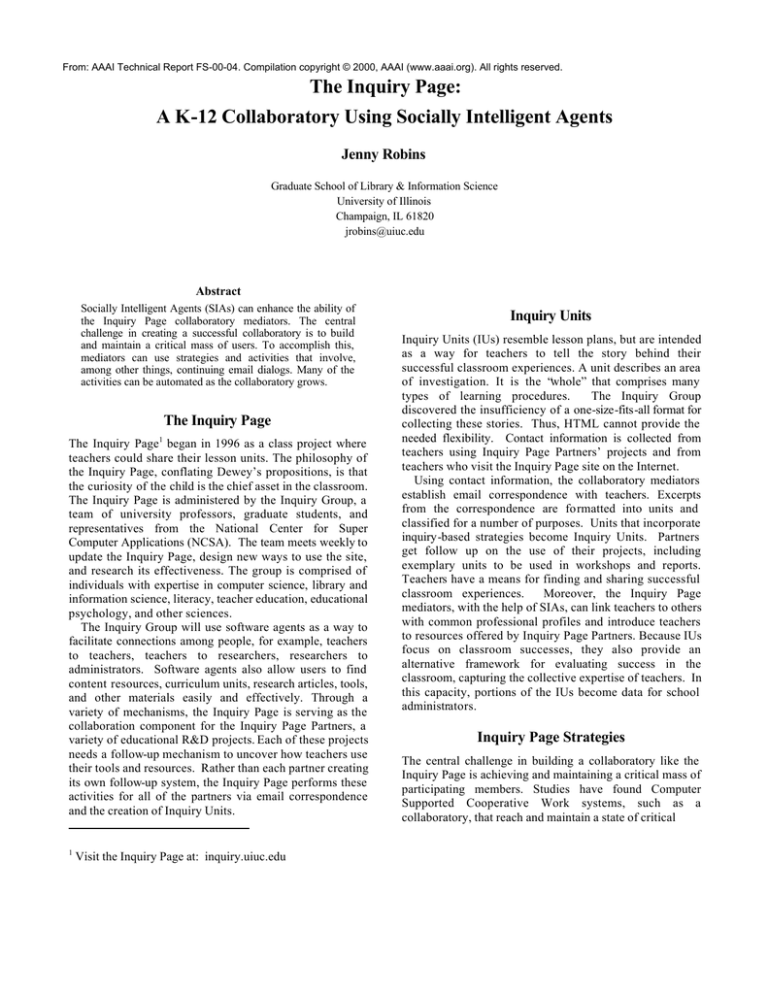
From: AAAI Technical Report FS-00-04. Compilation copyright © 2000, AAAI (www.aaai.org). All rights reserved.
The Inquiry Page:
A K-12 Collaboratory Using Socially Intelligent Agents
Jenny Robins
Graduate School of Library & Information Science
University of Illinois
Champaign, IL 61820
jrobins@uiuc.edu
Abstract
Socially Intelligent Agents (SIAs) can enhance the ability of
the Inquiry Page collaboratory mediators. The central
challenge in creating a successful collaboratory is to build
and maintain a critical mass of users. To accomplish this,
mediators can use strategies and activities that involve,
among other things, continuing email dialogs. Many of the
activities can be automated as the collaboratory grows.
The Inquiry Page
The Inquiry Page1 began in 1996 as a class project where
teachers could share their lesson units. The philosophy of
the Inquiry Page, conflating Dewey’s propositions, is that
the curiosity of the child is the chief asset in the classroom.
The Inquiry Page is administered by the Inquiry Group, a
team of university professors, graduate students, and
representatives from the National Center for Super
Computer Applications (NCSA). The team meets weekly to
update the Inquiry Page, design new ways to use the site,
and research its effectiveness. The group is comprised of
individuals with expertise in computer science, library and
information science, literacy, teacher education, educational
psychology, and other sciences.
The Inquiry Group will use software agents as a way to
facilitate connections among people, for example, teachers
to teachers, teachers to researchers, researchers to
administrators. Software agents also allow users to find
content resources, curriculum units, research articles, tools,
and other materials easily and effectively. Through a
variety of mechanisms, the Inquiry Page is serving as the
collaboration component for the Inquiry Page Partners, a
variety of educational R&D projects. Each of these projects
needs a follow-up mechanism to uncover how teachers use
their tools and resources. Rather than each partner creating
its own follow-up system, the Inquiry Page performs these
activities for all of the partners via email correspondence
and the creation of Inquiry Units.
1
Visit the Inquiry Page at: inquiry.uiuc.edu
Inquiry Units
Inquiry Units (IUs) resemble lesson plans, but are intended
as a way for teachers to tell the story behind their
successful classroom experiences. A unit describes an area
of investigation. It is the “whole” that comprises many
types of learning procedures.
The Inquiry Group
discovered the insufficiency of a one-size-fits-all format for
collecting these stories. Thus, HTML cannot provide the
needed flexibility. Contact information is collected from
teachers using Inquiry Page Partners’ projects and from
teachers who visit the Inquiry Page site on the Internet.
Using contact information, the collaboratory mediators
establish email correspondence with teachers. Excerpts
from the correspondence are formatted into units and
classified for a number of purposes. Units that incorporate
inquiry-based strategies become Inquiry Units. Partners
get follow up on the use of their projects, including
exemplary units to be used in workshops and reports.
Teachers have a means for finding and sharing successful
classroom experiences.
Moreover, the Inquiry Page
mediators, with the help of SIAs, can link teachers to others
with common professional profiles and introduce teachers
to resources offered by Inquiry Page Partners. Because IUs
focus on classroom successes, they also provide an
alternative framework for evaluating success in the
classroom, capturing the collective expertise of teachers. In
this capacity, portions of the IUs become data for school
administrators.
Inquiry Page Strategies
The central challenge in building a collaboratory like the
Inquiry Page is achieving and maintaining a critical mass of
participating members. Studies have found Computer
Supported Cooperative Work systems, such as a
collaboratory, that reach and maintain a state of critical
Activities
Prosocial
Donating
Help-Giving
Gaining
Recognition
A1
A2
A3
A4
A5
A6
A7
A8
X
X
X
X
X
X
X
X
X
X
A9
A10
A11
X
X
X
X
A12
A13
A14
X
Add Value
Donating
X
X
X
X
X
X
X
Adaptive
X
X
X
Indexing
Feedback
X
X
X
X
Searching
X
X
Collaborative
X
X
X
X
Browsing
Table 1. Prosocial and value added collaboratory activities performed by the Inquiry Page mediators.
contained in the collaboratory, can activate outside
mass, are likely to succeed (Dieberger 1999). Critical mass
searching for that resource on the Internet. The resource
refers to the threshold of individual actions that must be
can then be “wrapped” and linked to the collaboratory
reached in order to produce and maintain a public good.
(Knoblock, et al. 1994). Searches can also be captured and
To enable the Inquiry Page collaboratory to reach critical
stored for other members to use as a form of collaborative
mass, two strategies are proposed:
browsing (Twidale et al. 1997). Thus the value of the
• Encourage pro-social behaviors within the collaboratory
collaboratory is increased by members’ usage.
• Add value to the collaboratory every time it is used
Prosocial behaviors are actions intended to promote the
well being of others. These actions tend to be selfreinforcing (Brief and Motowidlo 1986).
Donating
resources and help-giving are examples of prosocial
behavior (Connolly and Thorn, 1990; Constant et al. 1996).
A collaboratory can be designed so that members’ acts of
kindness are visible to the entire community as a means of
gaining recognition. Recognition can provide a means for
social navigation in the collaboratory community, linking
members, as well recommending exemplary units.
Donating is both a prosocial act and a value-adding
activity. Other value adding activities include adaptive
indexing where keywords are accumulated “relatively
painlessly” by collecting them from real users under
authentic conditions (Furnas et al. 1987). Collecting
feedback can also add value to the collaboratory. Every
user’s act, even a brief examination of a resource, increases
the value of the collaboratory in some way, if only to
update a counter. Occasionally extensive feedback might be
collected. If this feedback includes information about how
a resource was used, it can be converted into a IU.
Moreover, acknowledging to users that their feedback has
been received, and passing feedback on, maximizes the flow
of personalized communication between the collaboratory
and its members, reinforcing the community through acts of
personal recognition. User requests for resources that fail,
meaning that the resource is not
Inquiry Page Activities
Table 1, above, presents the first phase of activities that the
Inquiry Page mediators, with the help of information
seeking agents and SIAs, perform. The activities are:
A1.
A2.
A3.
A4.
Maintain administrative databases
Invite casual users to join the collaboratory
Generate initial, editable teacher profiles
Send acknowledgments of contributed resources and
units to teachers and administrators
A5. Solicit additional information about units
A6. Fulfill teachers’ requests for units and resources
inside and outside the collaboratory
A7. Suggest resources to teachers based on their profiles
A8. Put teachers with similar interests in touch
A9. Provide workspace and tools for joint creation
A10. Provide chat rooms and web boards
A11. Help teachers with collaboratory related technical
problems
A12. Conduct formal evaluations of resources and
generate evaluation reports
A13. Construct new resources from user responses,
queries and feedback
A14. Convert resource files to the most commonly used
file types.
Concludsion
Figure 1. Inquiry Page Agent Architecture
Architecture for the Inquiry Page
Conclusion
Implementation of the strategies listed in the last section
will not only enrich the value of the collaboratory collection
by the addition of a information and resources, but will also
activate social networks. People within the community can
be made more aware of each other’s prosocial behavior.
With each communication activity, social ties are
strengthened. As the collaboratory reaches critical mass,
software agents can assist with many of the mediator
activities as illustrated in Figure 1 above.
Software agents can extend the ability of human mediators
in the Inquiry Page collaboratory, making it possible to
maintain social connections with a variety of stakeholders
through the creation of Inquiry Units.
Each teacher has a Member Agent which:
• maintains a usage history of the teacher’s requests
• records permissions and history of contributed resources
Connolly, T. and Thorn, B. 1990. Discretionary databases:
Theory, data, and implications. In Organizations and
Communication Technology, 219-233. Newbury Pk: Sage
There is one Broker Agent on each server which:
• directs requests for resources
• sends log data to the mediator
Constant, D. Kiesler, S. and Sproul, L. 1996.The kindness of
strangers: The usefulness of electronic weak ties for
technical advice. Organizational Science, 7(2), 119-135.
A Resource Agent is created for each resource to:
• convert files to universal formats
• create and update the unit keyword index entry
• update the unit feedback elements
• send unit keywords to the Broker Agent
Dieberger, A. 1999. Social connotations of space in the
design for virtual communities and social navigation. In
SocialNavigationof Information Space. London: Springer.
Humans and Mediator Agents (SIAs) share the role of
mediator. Humans supervise and train agents to handle a
variety of activities. Mediators are responsible for all
collaboratory communication, including:
• answering requests for technical help
• requesting and acknowledging contributions
• recommending resources and units
• forwarding recognition as appropriate
• running evaluation processes
• sending feedback to the Resource Agent
References
Brief, A. and Motowidlo, S. 1986. Prosocial organizational
behaviors. Academy of Management. Review, 11(4), 710-725.
Furnas, G.W., Landauer, T.K., Gomez, L.M. and Dumais, S.T.
1987. The vocabulary problem in human-system
communication. Communications of the ACM, 30(11), 964971.
Knoblock, C.A. and Ambite, J.L. 1997. Agents for
information gathering. In Software Agents. Menlo Park,
California: AAAI/MIT Press.
Twidale, M.B., Nichols, D.M. and Paice, C.D. 1997. Browsing
is a collaborative process. Information Processing and
Management, 33(6), 761-783.

